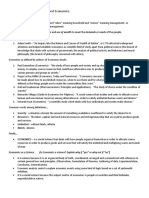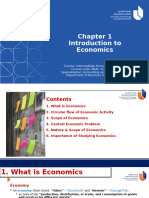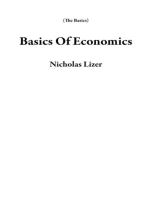0 ratings0% found this document useful (0 votes)
3 viewsIntroduction_to_Economics
The document provides an overview of economics, highlighting its importance in everyday life and its two main branches: macroeconomics and microeconomics. It discusses key concepts such as scarcity, opportunity cost, and different economic systems, including traditional, command, market, and mixed economies. Additionally, it distinguishes between positive and normative economics, and introduces applied economics as a practical application of economic theory to solve specific problems.
Uploaded by
ralphianrivera29Copyright
© © All Rights Reserved
Available Formats
Download as DOCX, PDF, TXT or read online on Scribd
0 ratings0% found this document useful (0 votes)
3 viewsIntroduction_to_Economics
The document provides an overview of economics, highlighting its importance in everyday life and its two main branches: macroeconomics and microeconomics. It discusses key concepts such as scarcity, opportunity cost, and different economic systems, including traditional, command, market, and mixed economies. Additionally, it distinguishes between positive and normative economics, and introduces applied economics as a practical application of economic theory to solve specific problems.
Uploaded by
ralphianrivera29Copyright
© © All Rights Reserved
Available Formats
Download as DOCX, PDF, TXT or read online on Scribd
You are on page 1/ 4
Applied Economics | closely connected to the
attainment and use of materials
INTRODUCTION TO ECONOMICS
requisites of the well-being.
Why do we need to study economics?
Two branches of Economics
- It affects our everyday lives
Macroeconomics – Affects whole - It is a
through important areas such as
division of economics that deals with the
tax, interest rates, wealth, and
overall performance of national and
inflation. Economists provide the
international economies.
tools by which analysts can study
the costs, benefits and effects of - It studies the economic system as
government policies in a range of a whole rather than the individual
areas that affect society. economic units that make up the
whole economy.
What is Economics? Microeconomics – Affects one - It is
concerned with behavior of individual
- Economics is the study of scarcity entities in the economy such as the
and its implications for the use of consumer, producer, and resource owner.
resources, production of goods and
services, growth of production and - It studies the decisions and choices
welfare over time, and a great of the individual units and how
variety of other complex issues of these decisions affect the prices of
vital concern to society. goods in the market.
- Economics is the study of how
people allocate scarce resources
Scarcity
for production, distribution, and
consumption, both individually and - It is the insufficiency of resources
collectively. to meet the needs and wants of
consumers and the insufficiency of
resources for producers that
Economics as a Social Science
hamper the production of enough
- Social science is the study of goods and services.
society and how people collectively -
behave and influence the world
Shortage
around us.
- Shortage exists when the available
supply of a good is not enough to
Economics
meet its demand.
- It is a social science that deals with SHORTAGE is not scarcity, but it can lead
how to allocate the scarce to one.
resources to satisfy man’s
unlimited needs and wants.
- ALFRED MARSHALL – he described
Opportunity Cost
economics as a study of mankind in
ordinary business of life. It - It refers to the value of the best
examines part of the individual and foregone alternatives.
social action, which are most
- It refers to the value of what is the answers to the basic economic
given up to acquire another goods. problems.
- The concept of opportunity cost
1. Traditional Economy
holds true for individuals,
businessmen, and even society. - decisions are based on traditions
and practices upheld over the years and
passed on from generation to generation.
Economic Sources
- methods are stagnant and are,
- Also known as factors of therefore, not progressive.
production, are basic inputs - traditional societies exist in
(foundation) used in the production primitive and backward civilizations.
of goods and services.
2. Command Economy
- this is the authoritative system
Factors of Production wherein decision-making is centralized in
the government or planning committee.
Land - It refers to natural resources that
are found in nature. - decisions are imposed on the
people who have no say in what goods
Labor - It refers to the human effort
are to be produced.
exerted in production which includes
manual workers such as construction - this economy holds true in
workers and machine operators and dictatorship and socialist states.
professionals like nurses, lawyers, and
doctors. 3. Market Economy
Capital - It refers to a man-made goods - this is the most democratic
used to produce other goods and economic system.
services which include machines, - producers and consumers decide
equipment, buildings, and construction. what, how, and for whom to produce
Entrepreneurship - It is the factor of collectively guided by the price system
production involved in combining the determined by supply and demand.
different resources/inputs used to 4. Mixed Economy
produce goods and services.
- it is a combination of the three
basic types of the economic systems.
Basic Economic Problem
1. What to produce? Why do we need to study Economics?
2. How to produce?
3. For whom to produce? - it affects our everyday lives
through important areas such as
tax, interest rates, wealth, and
inflation. Economists provide the
Economic System
tools by which analysts can study
- The economic system is the means the costs, benefits and effects of
through which society determines government policies in a range of
areas that affect society.
- The study of economics helps Normative Economics – Opinion and
people understand the world Subjective
around them. It enables people to
understand people, businesses,
markets and governments, and Measuring the Economics (Main Metrics)
therefore better respond to the
threats and opportunities that Gross Domestic Product (GDP)
emerge when things change. Formula: GDP = GNP – NFIA
GDP per Capita =
Positive Economics GDP/Population
- This is a study of what is actually
happening in the economy like Gross National Product (GNP)
current inflation rates, national
income, and employment. Formula: GNP = GDP + NFIA
- It is objective because it is - Net factor income from Abroad
supposed to be devoid of bias for (NFIA) can be calculated by
what is not real. subtracting the payments made to
Example: "An increase in the foreign factors of production within
minimum wage will lead to a decrease a country from the payments made
in the employment rate" is a positive to domestic factors of production
economic statement as it can be by the rest of the world. Net factor
tested using data and observations. income is a component of the
broader measure of the balance of
payments, and it helps determine a
nation's gross national income
Normative Economics
(GNI).
- This is a study of what should be, Formula:NFI=(Incomeearnedbydomesticf
like dispersing business investment actorsfromabroad)−
toward countryside to reduce rural (Incomeearnedbyforeignfactorswithinthec
poverty incidences to a tolerate ountry)
level by international standard.
- It is subjective judgments and
values. It deals with how the
Gross Domestic Product (GDP)
economy should be, based on
ethical considerations and societal - represents the total monetary
preferences. value of all goods and services
- Example: "The government should produced within a country's
increase spending on education to borders over a specific period
improve overall societal welfare" is (usually quarterly or annually).
a normative economic statement
because it involves a value
judgment about what the Gross National Product (GNP)
government ought to do.
- Similar to GDP, but it measures the
Positive Economics – Factual and
value of all final goods and services
Objective
produced by a country's citizens
and businesses, regardless of
location.
Applied Economics
- It is the application of economic
theory and quantitative tools to
analyze specific economic
problems and other inquiries with
the end of providing solutions and
new directions.
- John Neville Keynes is attributed to
be the first to use the phrase
“Applied Economics”.
You might also like
- Economics, 19th Edition by Samuelson, ReviewerNo ratings yetEconomics, 19th Edition by Samuelson, Reviewer11 pages
- Applied Economics: Economics As A Social Science and As Applied ScienceNo ratings yetApplied Economics: Economics As A Social Science and As Applied Science6 pages
- Introduction to Applied Economics Chapter 1 2No ratings yetIntroduction to Applied Economics Chapter 1 231 pages
- Employment Investment Income General Level of Prices/pricingNo ratings yetEmployment Investment Income General Level of Prices/pricing4 pages
- Economics Is A Science: Applied Economics Nature of EconomicsNo ratings yetEconomics Is A Science: Applied Economics Nature of Economics6 pages
- Applied Economics With Activity Grade 12No ratings yetApplied Economics With Activity Grade 1223 pages
- Applied Economics Reviewer For Midterm ExaminationNo ratings yetApplied Economics Reviewer For Midterm Examination8 pages
- Theme 1. Introduction Is To The Economic TheoryNo ratings yetTheme 1. Introduction Is To The Economic Theory20 pages
- Economics: Guide To Economics For Filipinos by Bernardo VillegasNo ratings yetEconomics: Guide To Economics For Filipinos by Bernardo Villegas71 pages
- Apecon LT 1 - Midterms Chapter 1: Introduction To Applied EconomicsNo ratings yetApecon LT 1 - Midterms Chapter 1: Introduction To Applied Economics5 pages
- Chapter 1 - Introduction to Economics GF (5)No ratings yetChapter 1 - Introduction to Economics GF (5)16 pages
- Nomos Meaning Management Household: Choices. - Means That Our ChoicesNo ratings yetNomos Meaning Management Household: Choices. - Means That Our Choices3 pages
- Download Complete Grow Fruit Alan Buckingham PDF for All Chapters100% (5)Download Complete Grow Fruit Alan Buckingham PDF for All Chapters85 pages
- DTC Agreement Between Cyprus and United StatesNo ratings yetDTC Agreement Between Cyprus and United States30 pages
- Policy Clauses New India Mediclaim PolicyNo ratings yetPolicy Clauses New India Mediclaim Policy30 pages
- Lake Milton Hydroelectric Project: Mahoning Hydropower, LLC100% (1)Lake Milton Hydroelectric Project: Mahoning Hydropower, LLC77 pages
- Oil and Petrochemical Overview - Solutions For Your ... - Spirax SarcoNo ratings yetOil and Petrochemical Overview - Solutions For Your ... - Spirax Sarco12 pages
- Biostatistics - Mean of Continuous SeriesNo ratings yetBiostatistics - Mean of Continuous Series5 pages
- Albina Omarova: Industrial Product DesignerNo ratings yetAlbina Omarova: Industrial Product Designer54 pages
- Instruction Manual: Autoclaves & SterilizersNo ratings yetInstruction Manual: Autoclaves & Sterilizers61 pages
- Phrasal Verbs About Clothes and FashionNo ratings yetPhrasal Verbs About Clothes and Fashion14 pages
- Persepsi Dan Motivasi Mahasiswa Dalam Memilih Program Studi Pada Jurusan Pendidikan Bahasa Dan SeniNo ratings yetPersepsi Dan Motivasi Mahasiswa Dalam Memilih Program Studi Pada Jurusan Pendidikan Bahasa Dan Seni11 pages
- Applied Economics: Economics As A Social Science and As Applied ScienceApplied Economics: Economics As A Social Science and As Applied Science
- Employment Investment Income General Level of Prices/pricingEmployment Investment Income General Level of Prices/pricing
- Economics Is A Science: Applied Economics Nature of EconomicsEconomics Is A Science: Applied Economics Nature of Economics
- Applied Economics Reviewer For Midterm ExaminationApplied Economics Reviewer For Midterm Examination
- Economics: Guide To Economics For Filipinos by Bernardo VillegasEconomics: Guide To Economics For Filipinos by Bernardo Villegas
- Apecon LT 1 - Midterms Chapter 1: Introduction To Applied EconomicsApecon LT 1 - Midterms Chapter 1: Introduction To Applied Economics
- Nomos Meaning Management Household: Choices. - Means That Our ChoicesNomos Meaning Management Household: Choices. - Means That Our Choices
- Download Complete Grow Fruit Alan Buckingham PDF for All ChaptersDownload Complete Grow Fruit Alan Buckingham PDF for All Chapters
- Lake Milton Hydroelectric Project: Mahoning Hydropower, LLCLake Milton Hydroelectric Project: Mahoning Hydropower, LLC
- Oil and Petrochemical Overview - Solutions For Your ... - Spirax SarcoOil and Petrochemical Overview - Solutions For Your ... - Spirax Sarco
- Persepsi Dan Motivasi Mahasiswa Dalam Memilih Program Studi Pada Jurusan Pendidikan Bahasa Dan SeniPersepsi Dan Motivasi Mahasiswa Dalam Memilih Program Studi Pada Jurusan Pendidikan Bahasa Dan Seni





























































































